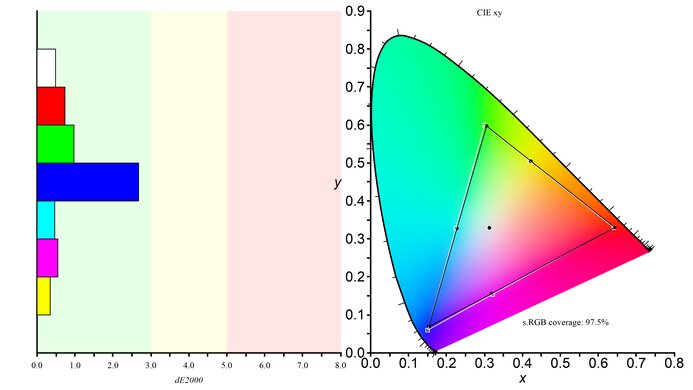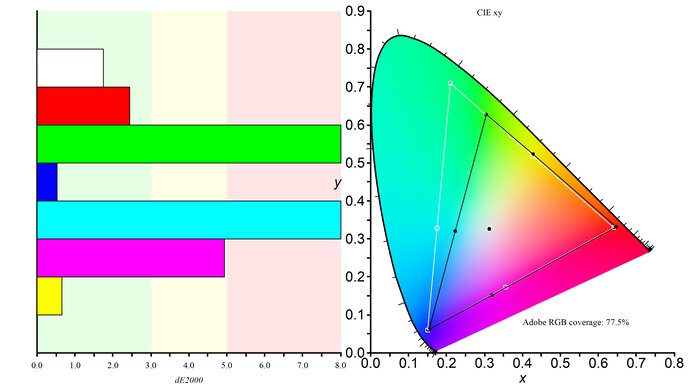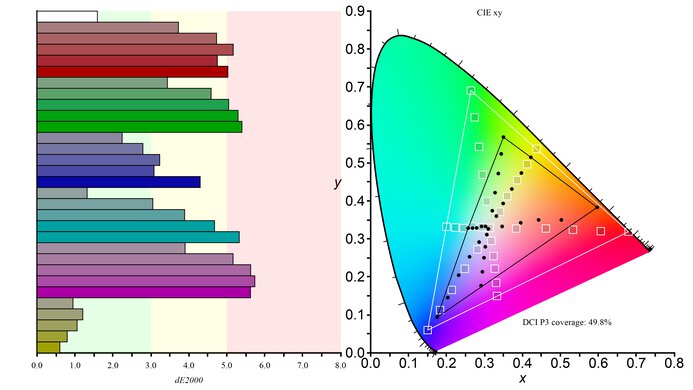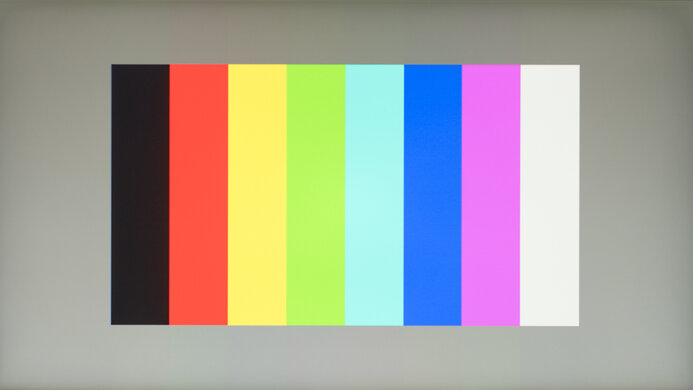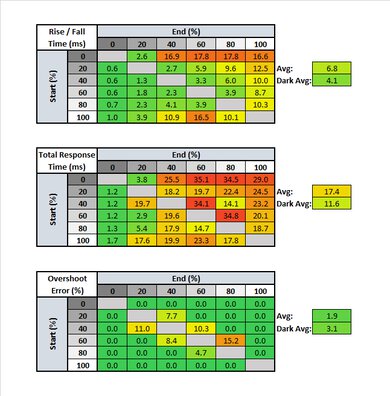The ASUS TUF Gaming VG258QM is a good overall monitor that delivers excellent performance. It's a 1080p TN monitor with a high 280Hz refresh rate, fast response time, and low input lag for smooth and responsive gaming. Unfortunately, the response time and input lag are worse at 60Hz. On the upside, it's well-suited to bright rooms due to its high peak brightness and great reflection handling. It also has an amazing SDR color gamut, but it doesn't perform well in HDR because it can't display a wide color gamut and doesn't get bright enough to bring out highlights. Viewing angles are also poor, resulting in image washout when viewing off-center, but it has fantastic ergonomics, so you can easily adjust the viewing position to suit your needs.
Our Verdict
The ASUS VG258QM is a good monitor for mixed usage. It performs best in bright lighting conditions thanks to its high peak brightness and great reflection handling. It's not as well-suited to watching movies or gaming in the dark because of its low contrast ratio. The high refresh rate, fast response time, and low input lag are excellent for gaming; however, response time and input lag perform worse at 60Hz. Unfortunately, it struggles with HDR, because it can't display a wide HDR color gamut and doesn't get bright enough to bring out highlights.
- Exceptionally high refresh rate.
- Low input lag.
- Great reflection handling.
- Fantastic ergonomics.
- Mediocre contrast ratio.
- Poor viewing angles.
- Smaller size is not ideal for multitasking.
The ASUS VG258QM is decent for office use. It has fantastic ergonomics, allowing you to make adjustments to your ideal viewing position. It also gets very bright and has great reflection handling, so glare shouldn't be an issue in well-lit rooms. That said, its smaller size is less suited for multitasking, and it only has a 1080p resolution. It also has poor viewing angles, making it difficult to share content.
- Great reflection handling.
- Fantastic ergonomics.
- Poor viewing angles.
- Smaller size is not ideal for multitasking.
The ASUS VG258QM is an excellent gaming monitor. It has an extremely quick response time at its max refresh rate, which is very high at 280Hz, resulting in exceptionally smooth motion. It also has a low input lag and supports VRR to reduce screen tearing. Unfortunately, the response time and input lag are much worse at 60Hz. Also, the 1080p resolution may not be high enough for some people.
- Fast response time at max refresh rate.
- Low input lag.
- Compatible with FreeSync and G-SYNC.
- Mediocre contrast ratio.
- Response time and input lag are significantly worse at 60Hz.
The ASUS VG258QM is decent for multimedia. It has great reflection handling, so glare shouldn't be an issue, and its ergonomics are superb, so you can set it to your ideal viewing position. However, the 1080p resolution may be too low if you prefer to watch movies in 4k, and the smaller screen size and poor viewing angles aren't well-suited to watching with another person.
- Great reflection handling.
- Fantastic ergonomics.
- Excellent SDR color gamut.
- Mediocre contrast ratio.
- Poor viewing angles.
- Small size is not ideal for watching movies and other media.
The ASUS VG258QM is good for media creation. It has an excellent SDR color gamut with good coverage of the Adobe RGB color space used in photo editing. It's easily adjusted to your ideal viewing position and has great reflection handling to cut glare. That said, the poor viewing angles cause the image to lose accuracy as soon as you move off-center, and the 1080p resolution may not be high enough for some content creators.
- Exceptionally high refresh rate.
- Great reflection handling.
- Fantastic ergonomics.
- Excellent SDR color gamut.
- Mediocre contrast ratio.
- Poor viewing angles.
- Smaller size is not ideal for multitasking.
The ASUS VG258QM is okay for HDR gaming, mostly due to its excellent gaming performance. The high refresh rate and fast response time result in clear motion in fast-moving games. However, it's not recommended for HDR gaming because of its poor HDR color gamut and low contrast ratio.
- Fast response time at max refresh rate.
- Low input lag.
- Compatible with FreeSync and G-SYNC.
- Poor HDR color gamut.
- Mediocre contrast ratio.
- Response time and input lag are significantly worse at 60Hz.
- Not bright enough to make HDR highlights pop.
Check Price
Differences Between Sizes And Variants
We tested the 25 inch ASUS TUF Gaming VG258QM, which is the only size available for this particular model. It's the TN variant of the ASUS TUF Gaming VG259QM, which uses an IPS panel. That said, there are several other monitors in the ASUS TUF Gaming lineup that are similar.
Our unit was manufactured in December 2020, and you can see the label here.
Popular Monitor Comparisons
The ASUS VG258QM is similar to the ASUS TUF Gaming VG259QM, except it uses a TN instead of an IPS panel. It's an excellent gaming monitor with a high 280Hz refresh rate, and its TN panel delivers crisp motion at its max refresh rate, but it has worse out-of-the-box color accuracy than most monitors. For other options, see our recommendations for the best gaming monitors, the best 24-25 inch monitors, and the best 240Hz monitors.
The ASUS TUF Gaming VG258QM is the TN variant of the ASUS TUF Gaming VG259QM. The TN panel, however, doesn't offer a significant advantage, as the VG259QM is a bit better in most ways that matter. They are very similarly built and look almost identical, but the IPS panel of the VG259QM has wider viewing angles and a slightly better contrast ratio. Most importantly, it has faster response times at both the max refresh rate and 60Hz, resulting in smoother motion. It also has a better HDR color gamut.
The ASUS TUF Gaming VG258QM is a bit better overall than the BenQ ZOWIE XL2546K, but they're both excellent for gaming due to their similarly fast response times. That said, the BenQ is better for gaming at 60Hz because it doesn't have the same input lag and response time issues that the ASUS does at 60Hz. They both use TN panels and suffer some of the same problems typical of that panel type, like narrow viewing angles and low contrast ratio. However, the ASUS gets significantly brighter, so it's better for well-lit rooms, and it feels better built.
The Dell G2524H and the ASUS TUF Gaming VG258QM are both entry-level 1080p, 280Hz gaming monitors. There are some differences between them, as the Dell has better uniformity and wider viewing angles. On the other hand, the ASUS gets brighter, so it's the better choice to use in well-lit rooms. The ASUS also supports HDR, which the Dell doesn't, but it doesn't add much due to its limited picture quality.
The ASUS TUF Gaming VG258QM and the ASUS ROG Swift 360Hz PG259QN use different panel types. While they both offer excellent gaming performance, the PG259QN is a bit better overall, though the VG258QM may represent a better value to some. The PG259QN uses an IPS panel, so it has wider viewing angles. It also has much better out-of-the-box color accuracy than the VG258QM, so you may not have to calibrate it. It has a higher refresh rate at 360Hz, but the 280Hz on the VG258QM is still very high and you likely won't notice a huge difference. While there's more overshoot, the PG259QN also has faster response times and it's significantly better for 60Hz gaming since the VG258QM has issues with response time and input lag at 60Hz.

We buy and test more than 30 monitors each year, with units that we buy completely on our own, without any cherry-picked units or samples. We put a lot into each unbiased, straight-to-the-point review, and there's a whole process from purchasing to publishing, involving multiple teams and people. We do more than just use the monitor for a week; we use specialized and custom tools to measure various aspects with objective data-based results. We also consider multiple factors before making any recommendations, including the monitor's cost, its performance against the competition, and whether or not it's easy to find.
Test Results

The ASUS VG258QM looks almost identical in design to the ASUS TUF Gaming VG259QM. It's simple and boxy, with a square stand and red accents that are typical of ASUS gaming monitors.
The back of the ASUS VG258QM is plastic with gamer-oriented etchings. Otherwise, it's quite simple, and it includes a cutout in the stand for cable management.
The ASUS VG258QM doesn't have a local dimming feature. The above video is provided for reference only.
The ASUS VG258QM has great SDR peak brightness. It's above the advertised 400 nits and stays consistent with different content. It should be enough to overcome glare in most lighting conditions.
We measured peak brightness after calibration using the 'Racing' Picture Mode with Brightness set to max.
The HDR peak brightness is okay. As with SDR brightness, it stays consistent when displaying different scenes, and it meets the advertised DisplayHDR 400 specification. It delivers a fair HDR experience, especially when viewing in the dark, although it may not be enough to make the brightest highlights pop as they should.
We measured the HDR brightness using the 'ASUS Gaming HDR' Picture Mode, in which the brightness setting is locked.
The ASUS VG258QM has mediocre horizontal viewing angles, but this is expected of a TN panel. The image loses accuracy as soon as you move off-center, which isn't ideal for co-op gaming. For a monitor with wide viewing angles, check out the LG 27GN800-B.
The ASUS VG258QM has poor vertical viewing angles, so the image looks inaccurate if you mount it above or below eye level. As with other TN monitors, it looks especially bad from below.
The ASUS VG258QM has decent gray uniformity, but this can vary between individual units. The upper section of the screen looks noticeably darker than the bottom, which is normal for TN panels. Thankfully, there isn't much dirty screen effect and uniformity is better in near-dark scenes.
The ASUS VG258QM has passable out-of-the-box color accuracy, though this can vary between units. There's an 'sRGB' Picture Mode, but it looks even worse, so we recommend the 'Racing' mode. Most colors are very off the mark, and while white balance is fairly accurate, there are still a lot of inaccuracies. Gamma doesn't follow the curve at all, so most scenes appear much brighter than they should, and the color temperature is colder than our target, resulting in a blue-tinted image.
After calibration, accuracy is fantastic. Any remaining inaccuracies with color and white balance shouldn't be noticeable without a colorimeter. Gamma is much improved, following the curve almost perfectly, except that very dark and very bright scenes may still be a tad over-brightened. The color temperature is almost exactly at our 6500K target.
You can download our ICC profile calibration here. This is provided for reference only and shouldn't be used, as the calibration values vary per individual unit due to manufacturing tolerances, even for the same model.
The ASUS VG258QM can't display a wide color gamut for HDR content. Its effective coverage of the common DCI P3 color space is worse than its coverage of the wider Rec. 2020. Given its Rec. 2020 coverage, it should be capable of showing approximately 70 percent of the DCI P3 color space, but the tone mapping is wildly inaccurate, so the effective color gamut ends up being much smaller. This means that if you're trying to play content that's sending a DCI P3 signal, the monitor has trouble interpreting the color signal correctly, resulting in an image that looks far from accurate. The mapping is a little better for Rec. 2020, but if you're playing a game in HDR that's sending a Rec. 2020 signal, it will still look pretty bad.
| Overdrive Setting | Response Time Chart | Response Time Tables | Motion Blur Photo |
| Level-0 | Chart | Table | Photo |
| Level-1 | Chart | Table | Photo |
| Level-2 | Chart | Table | Photo |
| Level-3 | Chart | Table | Photo |
| Level-4 | Chart | Table | Photo |
| Level-5 | Chart | Table | Photo |
The response time at the ASUS VG258QM's max refresh rate is outstanding, resulting in minimal motion blur. We recommend the 'Level 3' overdrive setting because it's the fastest without too much overshoot.
| Overdrive Setting | Response Time Chart | Response Time Tables | Motion Blur Photo |
| Level-0 | Chart | Table | Photo |
| Level-1 | Chart | Table | Photo |
| Level-2 | Chart | Table | Photo |
| Level-3 | Chart | Table | Photo |
| Level-4 | Chart | Table | Photo |
| Level-5 | Chart | Table | Photo |
At 60Hz, the ASUS VG258QM's response time is significantly worse than at its max refresh rate. It has a strange issue where it can't hit the target brightness within one refresh cycle, so the pixels stabilize too early, and then finally hit the target after two refreshes. It's especially apparent in the 0-40, 0-60, 0-80, and 0-100 transitions. For instance, you can see this happening here in the 0-60 transition, where it doesn't hit the target threshold within one refresh (about 16ms). Practically speaking, this results in noticeable smearing and duplications, as you can see behind our logo in the photo above. If you want a similar monitor with better response times at 60Hz, check out the ASUS TUF Gaming VG249Q1A.
The ASUS VG258QM has an optional Black Frame Insertion (BFI) feature, also known as backlight strobing, which can help reduce motion blur. On ASUS monitors, the BFI feature is called Extreme Low Motion Blur (ELMB), and it has five different 'Clarity' levels, which adjust the duration of the backlight strobing. Higher clarity levels hold black frames for longer, resulting in a darker image overall, meaning there's a trade-off between clarity and brightness. This monitor also lets you choose the 'Clarity Position', which changes whether the top, middle, or bottom part of the screen has more clarity by shifting the timing of the flicker pattern. Our photo and graph above are from 'Clarity' level 5, but you should adjust the BFI settings to whatever looks best to you. Note that our BFI score is based on the minimum and maximum frequency at which it operates, not the BFI's performance.
You can see the difference between 'Clarity' levels in the chart below.
| Clarity Level | Motion Blur Photo |
| Level 1 | Photo |
| Level 2 | Photo |
| Level 3 | Photo |
| Level 4 | Photo |
| Level 5 | Photo |
The ASUS TUF VG258QM has a native refresh rate of 240Hz that can be overclocked to 280Hz in the OSD 'Overclock' menu, although it can only be overclocked over DisplayPort. It's compatible with FreeSync VRR and is NVIDIA-certified as G-SYNC compatible, but the latter doesn't work over HDMI.
The ASUS VG258QM has an incredibly low input lag at its max refresh rate. Like the ASUS TUF Gaming VG259QM, it's significantly worse at 60Hz, so it's less suitable for console games running at 60fps. The max refresh rate you can get with 10 bit HDR over both DisplayPort and HDMI is 144Hz. We measured the HDR input lag with a 12 bit signal over HDMI at 144Hz because we had an issue getting 10 bit to work over HDMI, as it kept running at 30Hz even though Windows showed the refresh rate as 144Hz. For some reason, it also showed the resolution as 3840x1080 when it clearly wasn't. These issues only occurred over HDMI and weren't present with either 8 bit or 12 bit.
The size and resolution are decent, although 1080p may not be high enough for those who prefer to have a sharper image. The size is great for gaming, but may not be big enough for productivity.
There's a USB port; however, it's a service port that doesn't support upstream and is only meant for firmware updates.
The ASUS VG258QM supports HDR10 and has built-in speakers. It also has a ton of additional features, including:
- Crosshair: Puts a virtual crosshair on the display for first-person shooter games.
- Timer: Puts a timer on the screen.
- FPS counter: Overlay that shows the current frame rate.
- Display alignment: Helps align monitors in a multi-monitor setup.
- Zoom: Zooms in to enlarge a section of the image.
- Shadow Boost: Helps make objects more visible in dark scenes.
- Blue light filter: Helps reduce eye strain.
























